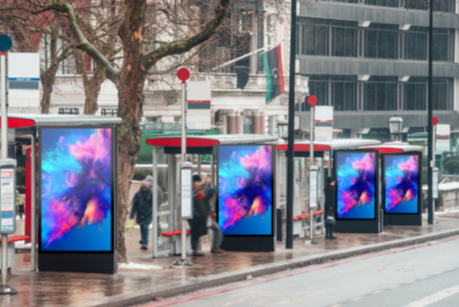The Power of Outdoor Digital Signage: Transforming the Way We Communicate

In an era dominated by technology, the traditional methods of advertising and communication are quickly being replaced by dynamic, interactive, and engaging digital solutions. Outdoor digital signage display have emerged as one of the most effective ways for businesses, governments, and organizations to communicate with their audience in public spaces. These vibrant and versatile displays are transforming outdoor advertising, enabling real-time updates and a level of engagement that traditional signage simply cannot provide.
What is Outdoor Digital Signage?
Outdoor digital signage refers to electronic displays, typically located in outdoor environments, that showcase digital content such as videos, images, advertisements, and real-time information. Unlike static billboards or posters, digital signage allows content to be changed instantly and frequently, keeping the message fresh and relevant to the target audience.
Outdoor digital signage displays are used in a wide variety of settings, from busy city streets and highways to retail locations, transportation hubs, and public squares. With the ability to reach large audiences in high-traffic areas, outdoor digital signage is an effective tool for marketing, information dissemination, and even entertainment.
The Rise of Outdoor Digital Signage
As technology has advanced, outdoor digital signage has evolved from simple static displays to sophisticated systems that provide rich, interactive, and multimedia content. These displays often feature high-resolution screens and can be controlled remotely, allowing businesses to tailor messages based on time, location, and audience demographics. In fact, outdoor digital signage has become so prevalent that it has nearly replaced traditional advertising methods in many industries.
Whether for displaying advertisements, providing real-time updates, or enhancing the visitor experience, outdoor digital signage serves as a powerful tool for communication. From large digital billboards in urban areas to interactive kiosks at airports, outdoor digital signage is becoming a ubiquitous presence in our daily lives.
Benefits of Outdoor Digital Signage
- Increased Visibility and Engagement
The primary benefit of outdoor digital signage is its ability to grab attention. The bright, colorful visuals and dynamic content are far more engaging than static billboards or printed advertisements. Whether it’s a large display along a busy street or a digital kiosk in a mall, these screens capture the eye of passersby and engage them with compelling content. With digital signage, businesses can create interactive experiences that encourage viewers to engage with the content, providing higher levels of customer interaction. - Real-Time Content and Flexibility
Unlike traditional signage that requires physical updates, outdoor digital signage display offer the flexibility of real-time content updates. This is particularly valuable for businesses or organizations that need to deliver timely information, such as breaking news, weather updates, event schedules, or sales promotions. For example, a restaurant could display its daily specials or a sports stadium could show live scores and highlights, ensuring that content is always fresh and relevant. - Cost-Effectiveness Over Time
Although the initial cost of installing outdoor digital signage can be higher than traditional signage, the long-term savings are significant. Traditional billboards and posters need to be printed and replaced regularly, which involves ongoing production and labor costs. In contrast, digital signage content can be updated remotely, eliminating the need for new prints and materials. Additionally, digital signage can be used for multiple purposes, allowing businesses to repurpose the display for advertising, promotions, and informational content without additional costs. - Sustainability
Outdoor digital signage is more environmentally friendly compared to traditional printed materials. Digital displays can be updated remotely, meaning there is no need to print new posters or waste materials. This reduces paper waste and the environmental impact associated with traditional advertising. Furthermore, many outdoor digital signage systems are designed with energy efficiency in mind, often incorporating LED technology that consumes less power. - Targeted Messaging
One of the most exciting developments in outdoor digital signage is the ability to deliver targeted, personalized content. Some digital signage systems use sensors or software to detect the demographic characteristics of the viewers—such as age, gender, and even mood—and tailor content accordingly. This level of personalization ensures that the message resonates with the specific audience, leading to higher engagement and conversion rates.
Applications of Outdoor Digital Signage
- Advertising and Marketing
The most common use for outdoor digital signage is advertising. Digital billboards along highways or in city centers can showcase high-quality advertisements for brands, products, or services. These advertisements can be programmed to change based on the time of day, location, or even weather conditions. For example, a clothing retailer might display different ads for winter coats in colder months and swimwear in the summer. The flexibility of digital signage enables businesses to tailor their marketing efforts more effectively. - Wayfinding and Directional Signage
In busy public spaces like airports, shopping malls, and office buildings, digital signage can serve as wayfinding tools, helping visitors navigate the area with ease. Interactive maps and directions displayed on digital kiosks can guide people to their desired destinations, such as a specific gate at an airport or a store in a shopping center. This makes it easier for people to find their way and enhances the overall experience in these spaces. - Public Information and Safety
Outdoor digital signage is often used to disseminate important public information. For example, in transportation hubs like train stations or bus terminals, digital signage can display real-time updates on schedules, delays, and routes. In times of emergency, these displays can quickly share critical safety information with the public. In city centers, digital signs can also be used to broadcast weather alerts, community announcements, and other timely notices. - Entertainment and Events
Outdoor digital signage is also widely used for entertainment purposes. From promoting upcoming concerts and theater performances to showcasing live events and performances, these displays provide an engaging way to keep the public informed about what’s happening in their area. Sports stadiums use digital signage to show live game footage, scores, and crowd interactions, creating a more immersive experience for fans.
Read Also: Smart Tips to Make the Most of Your Draper Lift Without Calling Tech Support Every Month
Challenges and Considerations for Outdoor Digital Signage
- Weather Conditions
Outdoor digital signage must be designed to withstand harsh weather conditions. Extreme temperatures, rain, snow, and direct sunlight can all impact the performance and longevity of digital displays. However, most modern digital signage systems are built with weather-resistant enclosures and anti-glare screens to ensure visibility even in challenging outdoor environments. - Maintenance and Upkeep
While outdoor digital signage systems require less physical maintenance than traditional signage, they still need to be checked regularly for software updates, hardware issues, and cleanliness. Keeping the screens free from dirt, dust, and debris is crucial to maintaining optimal performance and clarity. - Power and Connectivity
Outdoor digital signage relies on a constant power supply and internet connectivity for updates and real-time content delivery. Ensuring that these systems have reliable power sources and connectivity is essential, particularly in remote locations. Solar-powered digital signage is becoming increasingly popular as a sustainable and cost-effective solution for areas without access to the power grid.
The Future of Outdoor Digital Signage
As technology continues to advance, the future of outdoor digital signage display looks bright. With innovations in AI, machine learning, and augmented reality, digital signage will become even more immersive and personalized. For instance, AI can help optimize content based on the preferences and behavior of viewers, while augmented reality can create interactive, engaging experiences for users in public spaces.
Furthermore, with the rise of 5G networks, outdoor digital signage will become more connected, enabling faster updates and real-time content delivery. This will open up even more possibilities for interactive advertising, public service announcements, and personalized content.
Conclusion
Outdoor digital signage has proven itself as a game-changing tool for businesses, governments, and organizations looking to communicate effectively with the public. With its ability to engage, inform, and entertain in real-time, digital signage is set to continue shaping the future of outdoor advertising and public communication. By embracing this innovative technology, organizations can connect with their audience more dynamically, deliver timely messages, and create unforgettable experiences in the public sphere.





